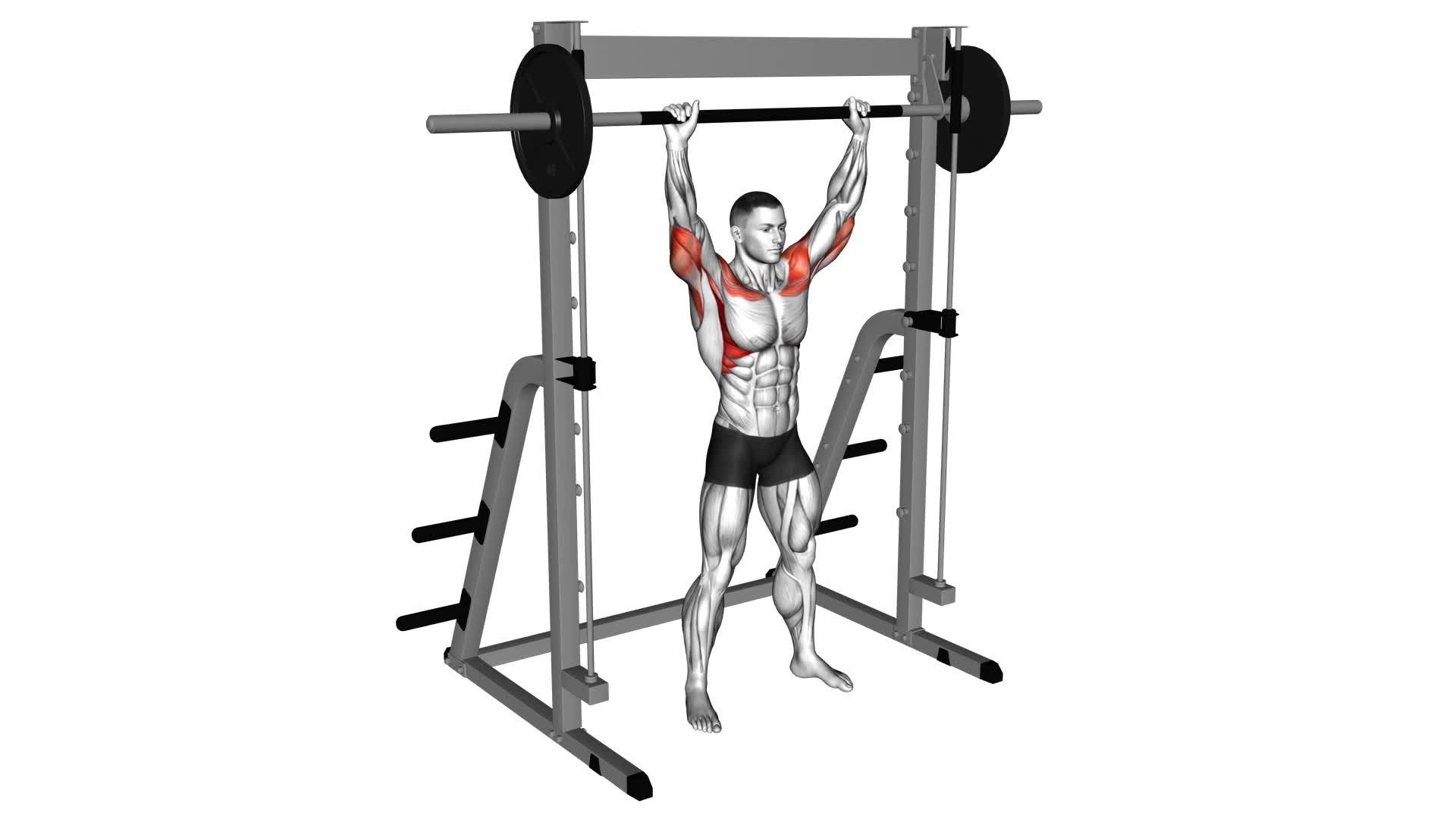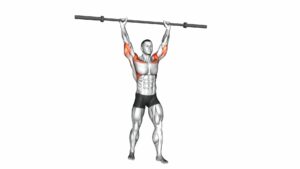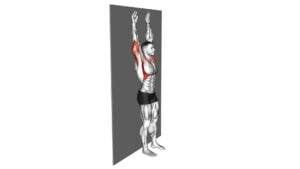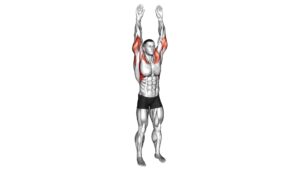Smith Standing Military Press – Video Exercise Guide & Tips

Are you looking to build strong shoulders and upper body strength?
Watch This Exercise Video
The Smith Standing Military Press is a powerful exercise that can help you achieve just that.
In this video exercise guide, we will show you the proper form and technique to perform this exercise effectively.
With step-by-step instructions and valuable tips, you'll learn how to avoid common mistakes and maximize muscle engagement.
Get ready to take your fitness to new heights with the Smith Standing Military Press.
Key Takeaways
- The Smith Standing Military Press targets shoulder muscles, triceps, and upper back muscles.
- It increases shoulder strength, stability, and improves posture.
- Proper equipment setup and safety precautions are essential for performing the exercise correctly and avoiding injury.
- Using proper form, avoiding excessive weight, and employing proper breathing techniques are crucial for stability and maximizing the benefits of the exercise.
Benefits of the Smith Standing Military Press
You can achieve numerous benefits through the Smith Standing Military Press. This exercise primarily targets your shoulder muscles, specifically the deltoids, and also engages your triceps and upper back muscles. By performing the Smith Standing Military Press, you can increase shoulder strength and stability, which is essential for various daily activities and other exercises. Additionally, this exercise helps improve posture by strengthening the muscles responsible for keeping your shoulders in a neutral position.
Another benefit of the Smith Standing Military Press is its versatility. You can perform this exercise with different grips, such as a wide grip or a close grip, to target specific areas of your shoulders. Variations like the seated military press or the Arnold press can also be incorporated to add variety to your shoulder training routine.
Furthermore, the Smith Standing Military Press promotes muscle balance by working both sides of your body equally. This helps prevent muscle imbalances, which can lead to injuries and postural issues. Incorporating this exercise into your workout routine can also enhance your overall upper body strength and power, contributing to improved performance in various sports and activities.
Proper Equipment Setup and Safety Precautions
To ensure a safe and effective Smith Standing Military Press, it's important to properly set up the equipment and take necessary safety precautions.
Before starting, make sure the Smith machine is adjusted to the appropriate height. The barbell should be set at shoulder level, allowing you to comfortably grip it with your hands slightly wider than shoulder-width apart. Check that the weight plates are securely fastened to the barbell to prevent any accidents during the exercise.
Additionally, it's crucial to maintain good form and technique throughout the exercise. Stand with your feet shoulder-width apart and keep your core engaged to provide stability and support. Before lifting the barbell, make sure your back is straight and your shoulders are pulled back. This will help prevent any strain or injury to your lower back and shoulders.
When performing the Smith Standing Military Press, it's important to start with a weight that you can comfortably handle. Gradually increase the weight as you become stronger and more confident in your form. Always listen to your body and avoid pushing yourself too hard, as this can lead to injury.
Remember to warm up before starting the exercise and cool down afterward to prevent any muscle soreness or stiffness. Lastly, if you have any pre-existing conditions or injuries, consult with a fitness professional or healthcare provider before attempting this exercise.
Step-by-Step Guide to Performing the Smith Standing Military Press
To perform the Smith Standing Military Press, start by standing with your feet shoulder-width apart and gripping the barbell with your hands slightly wider than shoulder-width apart. Here is a step-by-step guide to help you perform this exercise correctly:
- Position yourself: Stand with your back straight and your chest up. Place the barbell on the supports of the Smith machine at shoulder height.
- Grip the bar: Grab the barbell with an overhand grip, palms facing forward. Make sure your hands are slightly wider than shoulder-width apart. This grip will provide stability and control throughout the movement.
- Lift the bar: With your core engaged and your feet firmly planted on the ground, lift the barbell off the supports. Push the barbell straight up until your arms are fully extended overhead, keeping your elbows slightly bent.
It is important to note that the recommended number of sets and reps for the Smith Standing Military Press may vary depending on your fitness goals and training program. However, starting with 3-4 sets of 8-12 reps is a good starting point for most individuals. As you become more comfortable and stronger, you can gradually increase the weight and intensity of the exercise.
Remember to always listen to your body and consult with a fitness professional if you have any concerns or questions.
Common Mistakes to Avoid During the Exercise
To ensure that you perform the Smith Standing Military Press correctly, it's important to pay attention to proper form. This means keeping your back straight, engaging your core, and not arching or leaning excessively.
Another common mistake to avoid is using excessive weight, as this can lead to poor form and potential injury.
Lastly, remember to utilize proper breathing techniques, such as exhaling during the exertion phase, to maintain stability and control throughout the exercise.
Proper Form Importance
Avoid these common mistakes to ensure proper form and maximize the benefits of the Smith Standing Military Press.
Maintaining proper form is crucial to prevent injury and get the most out of this exercise. Here are three important tips to help you achieve proper form:
- Keep your core engaged: Engaging your core muscles throughout the movement will help stabilize your body and protect your lower back.
- Maintain a neutral spine: Avoid arching or rounding your back during the exercise. Keep your spine in a neutral position to ensure proper alignment and reduce the risk of injury.
- Control the weight: Avoid using momentum or jerking movements to lift the weight. Instead, focus on a slow and controlled motion, emphasizing proper muscle engagement.
By following these tips, you can optimize your Smith Standing Military Press and reap its benefits, such as increased shoulder strength and muscle development.
Remember to consult a professional if you need assistance with variations or modifications to suit your fitness level.
Avoiding Excessive Weight
Don't overload the barbell with too much weight when performing the Smith Standing Military Press. It's important to avoid excessive weight to prevent injury and ensure proper form during the exercise.
Start with a weight that allows you to maintain proper technique and gradually increase the load as you become stronger. Overloading the barbell can put excessive strain on your joints, particularly your shoulders, and increase the risk of injury.
It's also crucial to warm up properly before starting the exercise to prepare your muscles and joints for the movement. A proper warm-up routine can help increase blood flow, improve flexibility, and reduce the likelihood of muscle strains or tears.
Breathing Techniques for Stability
Maintain stability and prevent common mistakes during the Smith Standing Military Press by utilizing proper breathing techniques. Breathing plays a crucial role in stability training, helping you maintain control and balance throughout the exercise.
Here are three key breathing techniques to enhance stability during the Smith Standing Military Press:
- Inhale before initiating the movement: Take a deep breath in before you start pushing the weight up. This helps stabilize your core and create a solid foundation.
- Exhale during the exertion phase: As you push the weight overhead, exhale forcefully through pursed lips. This exhalation aids in generating power and maintaining stability.
- Inhale during the lowering phase: While bringing the weight back down, take a deep breath in. This prepares your body for the next repetition and helps maintain stability throughout the movement.
Tips to Improve Your Form and Maximize Muscle Engagement
To improve your form and maximize muscle engagement during the Smith Standing Military Press, there are a few key points to keep in mind.
First, focus on maintaining proper alignment by keeping your feet shoulder-width apart, your core engaged, and your back straight throughout the movement.
Second, make sure to engage the target muscle groups, primarily the shoulders and triceps, by pressing the barbell overhead in a controlled manner.
Lastly, don't forget to use proper breathing techniques to stabilize your body and enhance your performance during the exercise.
Proper Alignment for Form
Improve your form and maximize muscle engagement by ensuring proper alignment during the Smith Standing Military Press. Here are some key tips to help you achieve optimal form:
- Proper grip: Start by gripping the barbell with your hands slightly wider than shoulder-width apart. This will provide stability and control throughout the movement.
- Shoulder mobility: Before starting the exercise, make sure your shoulders are properly warmed up and mobile. This will allow for a full range of motion and prevent any potential injuries.
- Spine alignment: Maintain a neutral spine throughout the exercise. Avoid excessive arching or rounding of the back, as this can put unnecessary stress on the spine.
By following these tips, you'll ensure that your form is on point and that you're engaging the target muscle groups effectively.
Now, let's move on to the next section and learn more about engaging those muscles for maximum results.
Engaging Target Muscle Groups
To effectively engage your target muscle groups during the Smith Standing Military Press, focus on activating the proper muscle groups throughout the exercise. Maximizing results and muscle activation techniques are key to getting the most out of this exercise.
Start by positioning yourself correctly with your feet shoulder-width apart and your knees slightly bent. Grip the bar with an overhand grip, slightly wider than shoulder-width apart.
As you press the bar upward, engage your shoulder muscles by squeezing your shoulder blades together and pushing your chest out. Avoid using too much momentum and focus on using your shoulder muscles to lift the weight.
Keep your core engaged throughout the movement to maintain stability and prevent lower back strain.
Breathing Techniques for Stability
Use proper breathing techniques to enhance stability and maximize muscle engagement during the Smith Standing Military Press. By incorporating these breathing techniques, you can improve your form and make the most out of your workout.
Here are three key breathing techniques to help you achieve stability and maximize muscle engagement:
- Exhale during the exertion phase: As you press the barbell overhead, exhale forcefully through your mouth. This helps activate your core muscles and stabilize your body throughout the movement.
- Inhale during the eccentric phase: When lowering the barbell back down, inhale deeply through your nose. This helps you maintain control and stability while preparing for the next repetition.
- Breathe rhythmically: Establish a steady breathing pattern that matches the tempo of your exercise. This promotes consistency and helps you maintain stability throughout the entire set.
Variations and Modifications for Different Fitness Levels
Choose the appropriate weight for your fitness level to effectively modify the Smith Standing Military Press. Whether you're a beginner or an advanced lifter, there are variations and modifications available to suit your needs.
For beginners, it's important to start with lighter weights and focus on proper form and technique. This will help you build a solid foundation and prevent injuries. One variation for beginners is to perform the exercise seated instead of standing. This provides extra stability and support, making it easier to control the movement.
Another variation for beginners is to use dumbbells instead of the Smith machine. Dumbbells allow for a greater range of motion and engage more stabilizer muscles. Start with lighter dumbbells and gradually increase the weight as you get stronger.
For advanced lifters, there are modifications that can make the Smith Standing Military Press more challenging. One modification is to perform the exercise on an incline bench. This targets the upper chest and shoulders more intensely. Another modification is to use resistance bands or chains to add extra resistance to the movement.
Remember to always listen to your body and adjust the weight and intensity according to your fitness level. It's important to challenge yourself but also prioritize safety and proper form. Consult with a fitness professional if you need guidance on the appropriate variations and modifications for your specific goals and fitness level.
Frequently Asked Questions
How Many Sets and Reps Should I Do for the Smith Standing Military Press?
To determine the ideal number of sets and reps for the Smith Standing Military Press, consider your fitness goals and current strength level. Generally, it's recommended to perform 3-4 sets of 8-12 reps.
However, you can modify this based on your preferences and abilities. Keep in mind that higher reps with lighter weights focus on endurance, while lower reps with heavier weights emphasize strength.
Experiment and find the right balance that challenges you while maintaining proper form.
Can I Use Dumbbells Instead of a Barbell for This Exercise?
Yes, you can definitely use dumbbells instead of a barbell for the Smith Standing Military Press. Using dumbbells for this exercise has its own set of benefits.
It helps improve your stability and balance as each arm works independently. Dumbbells also allow for a greater range of motion, targeting different muscle fibers. Additionally, using dumbbells can help prevent muscle imbalances and promote overall muscle growth.
Is It Necessary to Warm up Before Performing the Smith Standing Military Press?
It is highly recommended to warm up before performing the Smith Standing Military Press. Dynamic stretching before this exercise helps to increase blood flow and flexibility, reducing the risk of injury.
Additionally, warming up prepares your muscles and joints for the movement patterns involved in the exercise.
There are different variations of the Smith Standing Military Press, such as using dumbbells instead of a barbell, which can target different muscle groups and add variety to your workout routine.
How Often Should I Incorporate the Smith Standing Military Press Into My Workout Routine?
To effectively incorporate the Smith Standing Military Press into your workout routine, consider your fitness goals and current training program. This exercise targets your shoulders, triceps, and upper back, providing strength and muscle development.
Start by performing the exercise 1-2 times per week, gradually increasing frequency as you progress. Remember to maintain proper form and use a weight that challenges you without compromising technique.
Consult a fitness professional for personalized guidance on incorporating the Smith Standing Military Press into your routine.
Can This Exercise Help With Shoulder Mobility and Flexibility?
Yes, the Smith Standing Military Press can indeed help improve shoulder mobility and flexibility. By performing this exercise with proper form, you engage the muscles in your shoulders, promoting shoulder stability.
The controlled movement of the press allows for a greater range of motion, helping to increase flexibility in the shoulder joint. It's important to maintain proper form throughout the exercise to avoid any potential injuries and maximize the benefits for your shoulder mobility.
Conclusion
In conclusion, the Smith Standing Military Press is a highly effective exercise for targeting and strengthening the shoulders, arms, and upper back.
By following the proper equipment setup and safety precautions, as well as maintaining correct form and avoiding common mistakes, you can maximize muscle engagement and achieve optimal results.
Whether you're a beginner or advanced fitness enthusiast, there are variations and modifications available to suit your fitness level.
So, incorporate this exercise into your routine and enjoy the benefits it brings to your overall strength and physique.

Author
Years ago, the spark of my life’s passion ignited in my mind the moment I stepped into the local gym for the first time. The inaugural bead of perspiration, the initial endeavor, the very first surge of endorphins, and a sense of pride that washed over me post-workout marked the beginning of my deep-seated interest in strength sports, fitness, and sports nutrition. This very curiosity blossomed rapidly into a profound fascination, propelling me to earn a Master’s degree in Physical Education from the Academy of Physical Education in Krakow, followed by a Sports Manager diploma from the Jagiellonian University. My journey of growth led me to gain more specialized qualifications, such as being a certified personal trainer with a focus on sports dietetics, a lifeguard, and an instructor for wellness and corrective gymnastics. Theoretical knowledge paired seamlessly with practical experience, reinforcing my belief that the transformation of individuals under my guidance was also a reflection of my personal growth. This belief holds true even today. Each day, I strive to push the boundaries and explore new realms. These realms gently elevate me to greater heights. The unique combination of passion for my field and the continuous quest for growth fuels my drive to break new ground.



